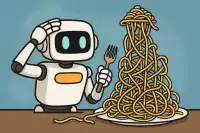![]() Why your AI suddenly fails at coding and how to fix itWhy your AI suddenly fails at coding and how to fix it
Why your AI suddenly fails at coding and how to fix itWhy your AI suddenly fails at coding and how to fix it

Last updated: May 8, 2025
Why do AIs start doing silly things with your code?
Because they create a mess — all by themselves.
AI-generated code often starts clean and shiny, but as you ask it to “just add this one thing” or “tweak that part,” it begins stacking ideas in weird places, mixing concerns, and tangling dependencies. It doesn’t really understand your system’s structure. It just imitates patterns.
Without guidance on cohesion and coupling, the AI slowly builds a spaghetti tower: functional, maybe, but wobbly and unpredictable.
Here’s is how to keep your code understandable to Cursor, Windsurf and all the other bastards.
🍳 Think of It Like Organizing Your Kitchen
- Cohesion is like keeping all your baking ingredients together, your pots and pans in another place, and your spices on a rack. Things that are related stay together.
- Coupling is about how dependent your appliances are on each other. If your toaster is hardwired into the microwave, that’s tight coupling. If both plug in separately, they’re loosely coupled.
🔗 Coupling: Limiting Dependencies
While cohesion is about what stays together, coupling is about how much one part depends on another.
- Low coupling is ideal, because humans can only juggle so many dependencies in their heads.
- When systems are tightly coupled, changing one part means changing many others too.
💣 Real-World Example: The Monolith
A monolithic app with extremely high coupling—where shipping rates, checkouts, and everything else can call each other freely—is hard to change. It’s a classic “Big Ball of Mud”: impossible to untangle, hard to reuse, and brittle.
🧼 In Summary
Striving for high cohesion and low coupling:
- Keeps software clean and organized
- Makes it easier to understand, extend, and fix
- Reduces bugs and boosts productivity
- Supports better team collaboration and faster innovation
And even if you’re not a coder, this kind of software hygiene ultimately leads to better, more adaptable, and more successful products.